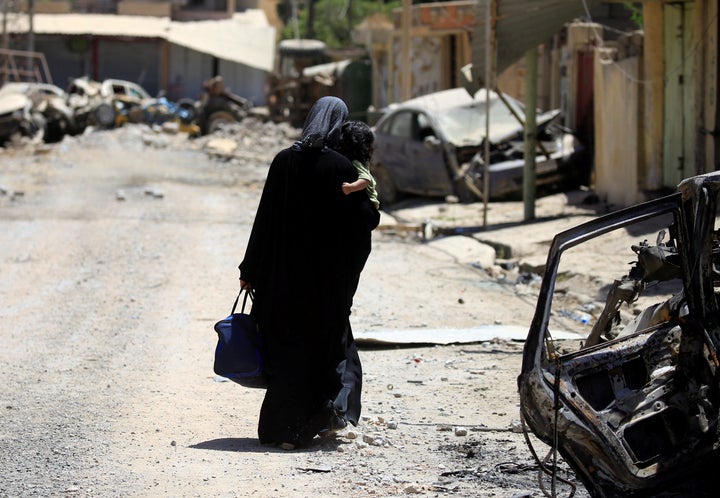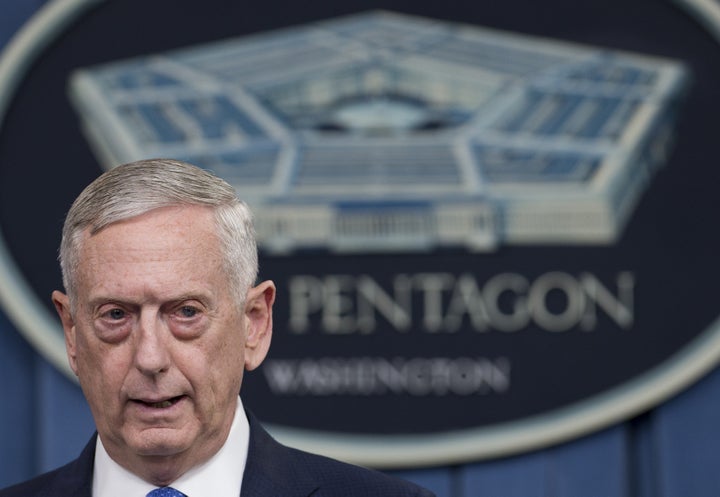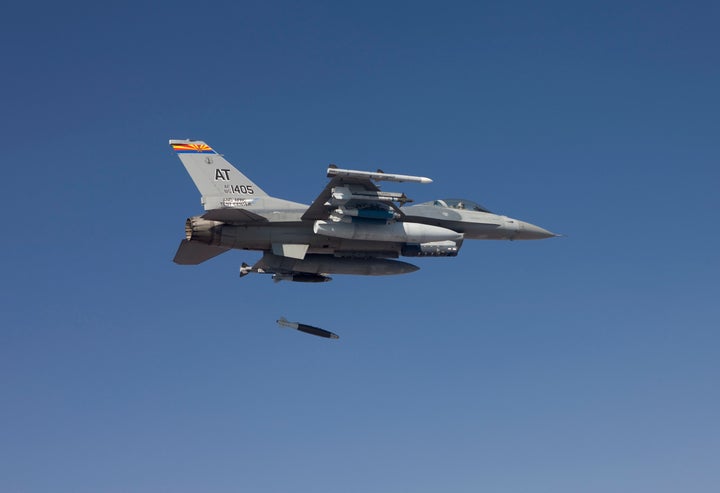
Overturning more than a decade of careful “hearts and minds” military operations, the United States has signaled that the major U.S.-backed combat offensives against ISIS in Iraq and Syria should proceed regardless of the cost to civilians.
Under orders to “annihilate” the extremist group that calls itself the Islamic State, the Defense Department is unleashing airstrikes, long-range artillery and rocket fire against ISIS-held neighborhoods in Raqqa, Syria, where civilians have been told by U.S.-backed militias to shelter in place. Meanwhile, airstrikes continue against ISIS positions in the Iraqi city of Mosul.
Until now, U.S. military forces operating across the region have taken extreme care to avoid causing harm to noncombatants. Under the counterinsurgency doctrine devised in 2006 and implemented in Iraq and Afghanistan under the direction of then-Gens. David Petraeus and Stanley McChrystal, protection of civilians took precedence over battlefield progress.
Those two senior field commanders prioritized civilian safety not just to comply with international law and American moral standards, but because doing so helped shore up the support of the local population against extremists. The unintentional killing of civilians, Petraeus and McChrystal pointed out, leads to local anger and resentment, undermining the legitimacy of the U.S. war effort and producing new extremist recruits.
“You can’t keep ’em on your side if you’re killing ’em,” explained a retired four-star combat commander.
The new guidance from Washington turns that upside down, setting battlefield success as a higher priority than the avoidance of civilian casualties.
Defense Secretary Jim Mattis said on June 5 that the new emphasis on killing, and the resulting rise in civilian casualties, are not because of any directive from President Donald Trump to loosen the rules on airstrikes. Rather, he said, it’s a new combat strategy that grew out of Trump’s demand for an “accelerated” war against ISIS extremists that sets the goal of “annihilating” ISIS fighters. Instead of “shoving them from one town to another and then falling back,” Mattis said, the U.S. and its allies are pushing to kill extremists and prevent them from slipping away to the West.
“We have changed not one bit of our rules of engagement,” he insisted during a press conference in Sydney. “We have relented not one bit in terms of trying to do everything humanly possible to protect the innocent on the battlefield... but at the same time, we’re going to have to take that [ISIS] caliphate down, or the attacks that you’ve seen going on around the world that you all have reported on will continue.”
“The enemy,” Mattis said, “has got to be taken out by military means where they are powerful enough to cause these attacks on others, and we can’t sit idly by and let them hold it.”

Speaking on CBS’ “Face the Nation” on May 28, Mattis allowed that “civilian casualties are a fact of life in this sort of situation.”
In practical terms, the shift means that the U.S. target engagement officers who receive airstrike requests have greater authority to grant them without approval from higher headquarters. It also means they have more flexibility to determine when the likelihood of causing civilian casualties is outweighed by the value of attacking specific targets. Those are subjective judgments usually made in consultation with a military lawyer.
Extremists fighting for ISIS have no such qualms, of course, and have slaughtered untold numbers of civilians across Iraq and Syria. Last week, advancing forces in west Mosul discovered the bodies of 163 men, women and children. They’d been shot by ISIS as they were fleeing, according to U.S. spokesman Col. Ryan Dillon.
Russian jets have pulverized parts of Syrian cities, and the Syrian regime, among other atrocities, has dropped more than 12,000 barrel bombs on dense urban neighborhoods.
The death toll in Syria alone has already exceeded 400,000 people through the end of 2016, and thousands of civilians are still at risk in the bloody doorway-to-doorway fighting against ISIS positions in Mosul and into Raqqa, the erstwhile ISIS capital in Syria.
U.S. aircraft have dropped at least 84,296 munitions on largely dense urban areas since the war against ISIS began in August 2014, according to Defense Department data through May 31.
Last month, the number of munitions the U.S. dropped on targets in Iraq and Syria jumped by more than 1,000 over April’s total, rising from 3,274 to 4,374 dropped in May. Those numbers don’t include rockets and artillery shells fired by U.S. forces.
In addition to airstrikes, the United States is firing long-range 155 mm howitzers into neighborhoods held by extremists. Each shell detonates in a fireball, shooting out nearly 2,000 red-hot steel fragments. Apache helicopter gunships are working over enemy positions, as are HIMARS multiple rocket launchers. The HIMARS, or High Mobility Artillery Rocket System, can fire the MGM-140B rocket, which is particularly dangerous for civilians. When the rocket detonates, it sprays out 274 spherical anti-personnel grenades, each of which has a killing radius of 50 feet when it explodes.
Civilians are suffering.
Since 2014, the U.S. Central Command said this month, its investigations into reports of civilian casualties determined it “more likely than not” that coalition airstrikes have killed at least 484 civilians. Independent investigations by organizations such as Airwars have documented that at least 3,817 civilians were actually killed by coalition airstrikes during that period.
Civilians will increasingly be at risk as Iraqi security forces, accompanied by U.S. combat advisers and backed by U.S. and allied airstrikes, push deeper into Mosul, where ISIS fighters are holding out in a maze of booby-trapped houses and cars and narrow alleyways barricaded with barbed wire and studded with improvised bombs.

The danger to civilians was clear in a March 17 U.S. airstrike that killed men, women and children sheltering on the first floor and basement of a house in the al-Jadidah district of Mosul, on the forward edge of advancing Iraqi government troops clashing with dug-in ISIS fighters.
A U.S. aircraft dropped a 500-pound guided bomb on the house, intended to kill two snipers reported on the rooftop. The resulting fireball and concussive blast reached deep into the structure, collapsing walls and floors of reinforced concrete and roaring down into the darkness, where the civilians had hoped they’d be safe.
In the moments before slabs of concrete began to fall, the pressure wave would have burst lungs, ears canals and intestines, leaving people in suffocating shock. Kidneys, bladders and livers would have been sheared away by the blast wave, and arms and legs severed as the fireball flash-charred skin and bone. The blast would have thrown bodies against the walls, smashing ribs and skulls. Mercifully, perhaps, survivors would then have been crushed beneath the collapsing rubble.
Eyewitnesses reported that children were heard crying from the wreckage. In the days it took rescuers to dig into the basement, their cries went silent.
Eventually, the bodies of 278 civilians were excavated, some of them children, according to Iraqi civil defense officials. U.S. officials said only 105 civilians had died in the airstrike. After an investigation, the Defense Department denied responsibility, saying the building was leveled not by the American bomb, but by a secondary detonation of an ISIS explosives cache set off by the airstrike.
This week, U.S.-backed Syrian forces led by Kurdish fighters began the final assault into Raqqa, where an estimated 3,000 ISIS fighters are dug in among 200,000 civilians trapped in the city. The Syrian Observatory for Human Rights, an independent group, reported that U.S. and allied warplanes were bombing suspected ISIS snipers and other targets. On Tuesday, U.S. Central Command reported it had conducted 29 airstrikes in Syria, including 22 against targets in Raqqa, and eight in northern Iraq.
There’s a reason the protection of war-zone civilians has been considered a vital part of ground combat operations, according to veteran commanders. “If a foreign force inflicts civilian casualties in an area that is contested but swaying toward the other side, that external force pays a significant penalty in local support,” said retired Army Col. Christopher Kolenda, who led an airborne regiment in eastern Afghanistan in 2007-2008 and later served as a senior strategist for McChrystal.
In his experience, Kolenda told HuffPost, “We’re at risk of losing if we don’t maintain the protection of civilians.”
